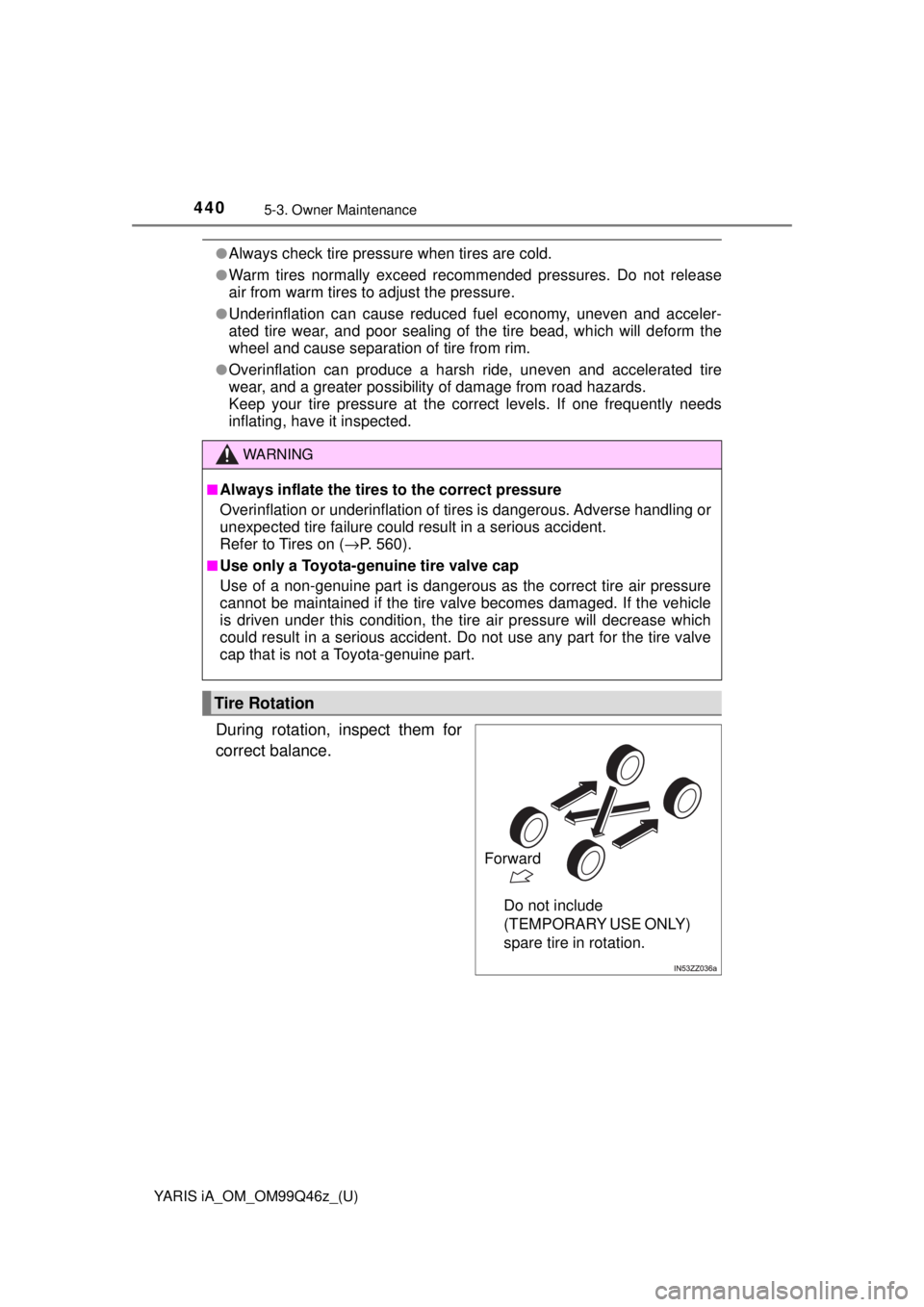2018 TOYOTA YARIS iA inflation pressure
[x] Cancel search: inflation pressurePage 220 of 576

220
YARIS iA_OM_OM99Q46z_(U)
3-12. Tire Pressure Monitoring System
NOTICE
●Each tire, including the spare (if provided), should be checked monthly
when cold and inflated to the inflation pressure recommended by the
vehicle manufacturer on the vehicle placard or tire inflation pressure
label. (If your vehicle has tires of a different size than the size indicated
on the vehicle placard or tire inflation pressure label, you should deter-
mine the proper tire inflation pressure for those tires.)
As an added safety feature, your vehicle has been equipped with a tire
pressure monitoring system (TPMS) that illuminates a low tire pres-
sure telltale when one or more of your tires is significantly under-
inflated. Accordingly, when the low tire pressure telltale illuminates,
you should stop and check your tires as soon as possible, and inflate
them to the proper pressure. Driving on a significantly under-inflated
tire causes the tire to overheat and can lead to tire failure. Under-infla-
tion also reduces fuel efficiency and tire tread life, and may affect the
vehicle’s handling and stopping ability.
Please note that the TPMS is not a s ubstitute for proper tire mainte-
nance, and it is th e driver’s responsibility to maintain correct tire pres-
sure, even if under-inflation has not reached the level to trigger
illumination of the TPMS lo w tire pressure telltale.
Your vehicle has also been equipped with a TPMS malfunction indica-
tor to indicate when the system is not operating properly.
The TPMS malfunction indicator is combined with the low tire pressure
telltale. When the system detects a malfunction, the telltale will flash
for approximately one minute and then remain continuously illumi-
nated. This sequence will contin ue upon subsequent vehicle start-ups
as long as the malfunction exists . When the malfunction indicator is
illuminated, the system ma y not be able to detect or signal low tire
pressure as intended. TPMS malfunctions may occur for a variety of
reasons, including the installation of replacement or alternate tires or
wheels on the vehicle that prevent the TPMS from functioning properly.
Always check the TPMS malfunction telltale after replacing one or
more tires or wheels on your vehi cle to ensure that the replacement or
alternate tires and wheels allow the TPMS to continue to function prop-
erly.
●To avoid false readings, the system samples for a little while before
indicating a problem. As a result it will not instantaneously register a
rapid tire deflation or blow out.
Page 417 of 576

417
YARIS iA_OM_OM99Q46z_(U)
5-3. Owner Maintenance
5
Maintenance and Care
Owner Maintenance Precautions
The owner or a qualified service technician should make these vehicle
inspections at the indicated inte rvals to ensure safe and dependable
operation.
Bring any problem to the attention of your Toyota dealer or qualified
service technician as soon as possible.
■When Refueling • Brake and clutch fluid level ( →P. 428)
• Engine coolant level ( →P. 425)
• Engine oil level ( →P. 424)
• Washer fluid level ( →P. 429)
■At Least Monthly
• Tire inflation pressures ( →P. 439)
■At Least Twice a Year (For Example, Every Spring and Fall)
You can do the following scheduled maintenance items if you have
some mechanical ability and a few basic tools and if you closely fol-
low the directions in this manual.
• Engine coolant ( →P. 425)
• Engine oil ( →P. 422)
Improper or incomplete service may result in problems. This section
gives instructions only for items that are easy to perform.
As explained in the Introduction ( →P. 412), several procedures can be
done only by a qualified service technician with special tools.
Improper owner maintenance during the warranty period may affect
warranty coverage. Refer to Introduction ( →P. 412) for owner’s
responsibility in protecting your in vestment. For details, read the sep-
arate Toyota Warranty and Mainten ance Guide provided with the vehi-
cle. If you are unsure about any se rvicing or maintenance procedure,
have it done by your Toyota dealer.
There are strict environmental laws regarding the disposal of waste oil
and fluids. Please dispose of your waste properly and with due regard
to the environment.
We recommend that you entrust the oil and fluid changes of your vehi-
cle to your Toyota dealer.
Page 439 of 576

439
YARIS iA_OM_OM99Q46z_(U)
5-3. Owner Maintenance
5
Maintenance and Care
Tires
Inspect all tire pressures monthly (including the spare) when the tires
are cold. Maintain recommended pressures for the best ride, han-
dling, and minimum tire wear.
Refer to the spec ification charts
(→P. 5 6 0).
With tire pressure monitoring system:
After adjusting the tire pressure, init ialization of the tire pressure mon-
itoring system is necessary to make the system operate normally.
Refer to Tire Pressure Monitoring System Initialization on P. 221.
For reasons of proper performance, safety, and better fuel econ-
omy, always maintain recommended tire inflation pressures and
stay within the recommended load limits and weight distribu-
tion.
WARNING
■Using Different Tire Types
Driving your vehicle with different ty pes of tires is dangerous. It could
cause poor handling and poor braking; leading to loss of control.
Except for the limited use of the temporary spare tire, use only the same
type tires (radial, bias-belted, bias-type) on all four wheels.
■Using Wrong-Sized Tires
Using any other tire size than what is specified for the vehicle (→P. 560)
is dangerous. It could seriously affect ride, handling, ground clearance,
tire clearance, and speedometer ca libration. This could cause you to
have an accident. Use only tires that are the correct size specified for
the vehicle.
Tire Inflation Pressure
Page 440 of 576

4405-3. Owner Maintenance
YARIS iA_OM_OM99Q46z_(U)
●Always check tire pressure when tires are cold.
●Warm tires normally exceed recommended pressures. Do not release
air from warm tires to adjust the pressure.
●Underinflation can cause reduced fuel economy, uneven and acceler-
ated tire wear, and poor sealing of the tire bead, which will deform the
wheel and cause separation of tire from rim.
●Overinflation can produce a harsh ride, uneven and accelerated tire
wear, and a greater po ssibility of damage from road hazards.
Keep your tire pressure at the correct levels. If one frequently needs
inflating, have it inspected.
During rotation, inspect them for
correct balance.
WARNING
■Always inflate the tires to the correct pressure
Overinflation or underinflation of tires is dangerous. Adverse handling or
unexpected tire failure could re sult in a serious accident.
Refer to Tires on ( →P. 560).
■Use only a Toyota-genuine tire valve cap
Use of a non-genuine part is danger ous as the correct tire air pressure
cannot be maintained if the tire valv e becomes damaged. If the vehicle
is driven under this c ondition, the tire air pr essure will decrease which
could result in a serious accident. Do not use any part for the tire valve
cap that is not a Toyota-genuine part.
Tire Rotation
Forward
Do not include
(TEMPORARY USE ONLY)
spare tire in rotation.
Page 489 of 576

YARIS iA_OM_OM99Q46z_(U)
4896-2. Flat Tire
6
If Trouble Arises
Pass the buckle through the wheel as shown in the figure and
secure it so that the buckle does not contact the wheel.
Pass the belt through the
buckle, then pull the belt end to
secure the flat tire.
Return the rear seatback on the right side of the rear seatback to its
original position.
Remove the tire blocks and store the tools and jack.
Check the inflation pressure.
Refer to Tires on P. 560.
Have the flat tire repaired or replaced as soon as possible.
●Do not press the tire pressure monito ring system set switch after install-
ing the spare tire. The switch is only to be pressed after installing the
repaired flat tire or inst alling a replacement tire ( →P. 148).
●To prevent the jack and tool from rattling, store them properly.
12
Aluminum wheelSteel wheel
13
●Pass the belt underneath the seat-
belts.
114
15
16
17
Seat beltBelt
Page 509 of 576

YARIS iA_OM_OM99Q46z_(U)
5096-7. Warning/Indicator Lights and Warning Sounds
6
If Trouble Arises
(Illuminate)
(if equipped)
Tire Pressure Monitoring
System Warning Light
When the warning light illu-
minates, and the warning
beep sound is heard (about
3 seconds), tire pressure is
too low in one or more tires.
Inspect the tires and
adjust to the specified
inflation pressure
(→ P. 439).
(Amber)
(if equipped)
Smart City Brake Support
(SCBS) Warning Light
The light turns on if the wind-
shield is dirty or there is a
malfunction in the system.
Vehicles with type B
audio
Verify the reason why the
warning light is illuminated
on the center display
( →P. 501).
If the reason why the
warning light is illuminated
is due to a dirty wind-
shield, clean the wind-
shield.
For any other reasons,
have the vehicle
inspected at your Toyota
dealer.
Vehicles without type B
audio
If the reason why the
warning light is illuminated
is due to a dirty wind-
shield, clean the wind-
shield. For any other
reasons, have the vehicle
inspected at your Toyota
dealer.
SignalWarningAction to be taken
Page 511 of 576

YARIS iA_OM_OM99Q46z_(U)
5116-7. Warning/Indicator Lights and Warning Sounds
6
If Trouble Arises
■Tire Pressure Monitoring System Warning Light
●
Perform tire pressure adjustment wh en the tires are cold. Tire pressure
will vary according to the tire temperature, therefore let the vehicle stand
for 1 hour or only drive it 1 mile (1.6 km) or less before adjusting the tire
pressures. When pressure is adjusted on hot tires to the cold inflation
pressure, the TPMS warning light/beep may turn on after the tires cool
and pressure drops below specification.
Also, an illuminated TPMS warning ligh t, resulting from the tire air pres-
sure dropping due to cold ambient temperature will remain illuminated
even if the ambient temper ature rises. In this case, it will also be neces-
sary to adjust the tire air pressures. If the TPMS warning light illuminates
due to a drop in tire air pressure, make sure to check and adjust the tire
air pressures.
●Tires lose air naturally over time and the TPMS cannot tell if the tires are
getting too soft over time or you have a flat. However, when you find one
low tire in a set of four-that is an indication of trouble; you should have
someone drive the vehicle slowly forward so you can inspect any low
tire for cuts and any metal objects sticking through tread or sidewall. Put
a few drops of water in the valve stem to see if it bubbles indicating a
bad valve. Leaks need to be address ed by more than simply reinflating
the tire as leaks are dangerous - take it to your Toyota dealer.
WARNING
■If the tire pressure monitoring system warning light illuminates or
flashes, or the tire pressure warning beep sound is heard, decrease
vehicle speed immediately and avoid sudden maneuvering and
braking
If the tire pressure monitoring system warning light illuminates or
flashes, or the tire pressure warning beep sound is heard, it is danger-
ous to drive the vehicle at high speeds, or perform sudden maneuvering
or braking. Vehicle driv ability could worsen and re sult in an accident.
To determine if you have a slow leak or a flat, pull over to a safe position
where you can check the visual condition of the tire and determine if you
have enough air to proceed to a place where air may be added and the
system monitored again by your Toyota dealer or a tire repair station.
■Do not ignore the TPMS Warning Light
Ignoring the TPMS warning light is da ngerous, even if you know why it
is illuminated. Have th e problem taken care of as soon as possible
before it develops into a more serious situation that could lead to tire
failure and a dangerous accident.
Page 516 of 576

5166-7. Warning/Indicator Lights and Warning Sounds
YARIS iA_OM_OM99Q46z_(U)
If the driver’s door is opened while the ignition is switched to ACC, a
continuous beep sound will be heard to notify th e driver that the igni-
tion has not been switched off (STOP). Left in this condition, the key-
less entry system will not operate, the car cannot be locked, and the
battery power will be depleted.
A beep sound will be hear d 6 times and the KEY warning light (red)
will flash continuously if the ignition has not been switched off, all the
doors are closed, and the key is remo ved from the vehicle. This is to
notify the driver that the key has been removed from the vehicle and
the ignition has not been switched off.
Because the key utilizes low-intensity radio waves, the Key Removed From
Vehicle Warning may activate if the key is carried together with a metal object
or it is placed in a poor signal reception area.
The warning beep sound will be heard for about 3 seconds when
there is any abnormality in tire inflation pressures (→P. 218).
If there is the possibility of a collis ion with a vehicle ahead, the beep
sounds continuously and a warning is indicated in the display.
If the power steering system has a malfunction, the power steering
malfunction light turns on or flashes and the buzzer operates at the
same time.
Refer to Warning/Indicator Lights on P. 156.
Ignition Not Switched Off (STOP) Warning Beep
Key Removed from Vehicle Warning Beep
Tire Inflation Pressure Warning Beep (if equipped)
Collision warning (if equipped)
Power Steering Warning Buzzer